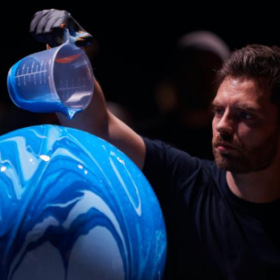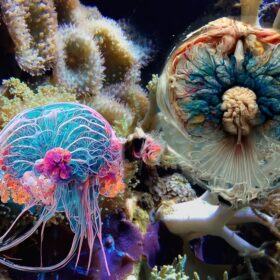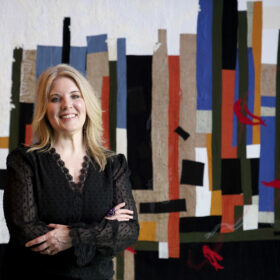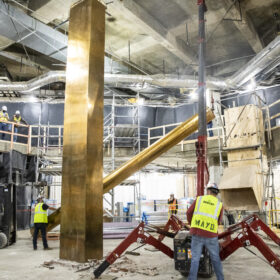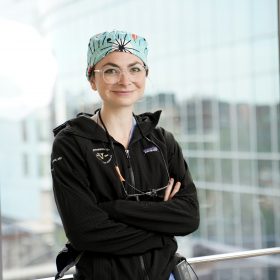VUMC has 2,500 pieces of art. Jenny Lewis knows them all.
Portraits, landscapes, sculptures — health care art is an art in itself
October 10, 2019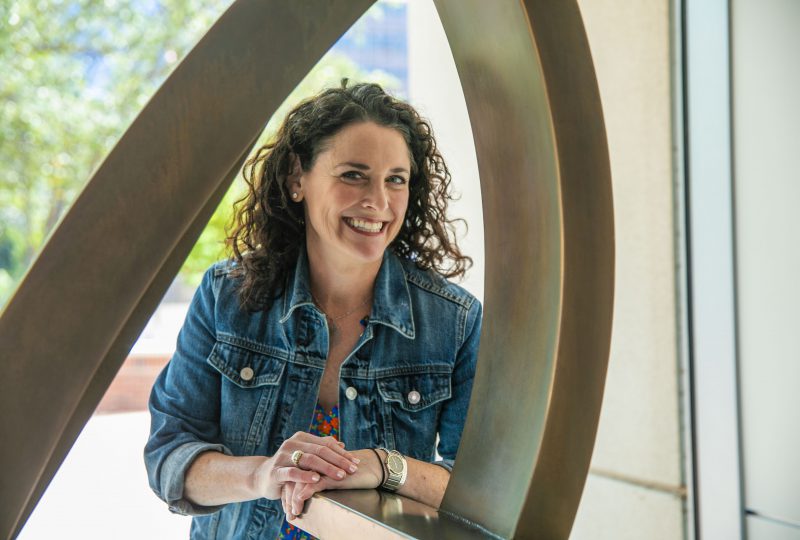
Jenny Lewis curates and places the art that fills the Medical Center. Photo by Anne Rayner
Ever wondered where all the beautiful sculptures and artwork that adorn Vanderbilt University Medical Center’s campus came from?
Behind every single picture frame and portrait across VUMC is Jenny Lewis — a full-time employee responsible for acquiring, placing, maintaining and insuring all of the Medical Center’s artwork.
For 24 years, Lewis has been charged with choosing art for clinics, inpatient rooms, lobbies, conference rooms and hallways that creates a calm and comfortable environment for patients and employees alike.
“There are all kinds of studies that show hospital stays are shorter and pain medication is used less if patients are comfortable in their environment.”
As if placing a collection of roughly 2,500 pieces isn’t enough to keep her busy, she’s also responsible for keeping track of it all.
“I can’t remember what’s on my grocery list, but I can remember that in 1998, Dr. X moved his office from Medical Center East to Medical Center North, and he took that one print with him,” laughed Lewis. “Now it’s all digitized, but for a long time it was literally just in my head.”
Lewis had never heard of health care arts when she first moved to Nashville, but when a vacant position opened in VUMC’s Cultural Enrichment department, she saw it as a chance to use her degree in art history.
“My parents would always ask, ‘What do you do, again?’ They were just happy I had a job with benefits and health insurance,” Lewis said.
Art placement in a health care setting is different from any other environment, requiring thoughtful planning and knowledge of the evidence that art can play a role in the healing process.
“Health care art is very specific. Things that are in my house I would never put in the Medical Center, and things in the Medical Center don’t necessarily belong in someone’s home. There are all kinds of studies that show hospital stays are shorter and pain medication is used less if patients are comfortable in their environment,” said Lewis.
“We just want to create a soothing, healing environment where people feel welcome.”
According to Lewis, adult patients prefer crisp photos of landscapes with clear horizon lines. Patients waking up from surgery want to be able to focus on something that’s easy to understand and avoids the appearance of being blurry or fuzzy.
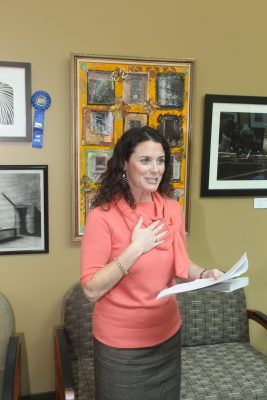
Lewis announces winners at an employee art show in 2011. File photo by Steve Green
Patients also feel more comfortable when the scenes look like home.
“People like what they’re familiar with. Here in Tennessee, they don’t want to see the Rocky Mountains — they want the Smokies. They don’t want a beach — they want a lake. Some people love beach vacations, but for some reason, in a hospital setting, they want farms and wooded areas. So, a lot of the landscapes you’ll see around the Medical Center are regional images that make people feel comfortable,” said Lewis.
Children tend to enjoy bright colors, silly humor and animals. For adolescents, pieces should strike a balance between being too “childish” and replicating adult areas.
Just as preferences exist, there are also things to avoid based on each population and how the area is used. Lewis pays particular attention to sensitivities in geriatric and behavioral health units and emergency departments.
“Most people don’t choose to be here in the hospital like they’d choose to visit a museum or an art gallery. We don’t want to challenge anyone, and we don’t want art that’s too edgy,” said Lewis.
“A sick person may view something so differently than a healthy person. A healthy person would see a still-life painting of a table with flowers as something beautiful, and a sick person may see it as flowers brought to a funeral. It’s fascinating where the mind goes.”
Common themes to avoid include scenes of fall, which is marked by dying leaves, and flowers that may be wilting. Similarly, abstract pieces can be interpreted in many ways and are best left out.
“A sick person may view something so differently than a healthy person,” said Lewis. “A healthy person would see a still-life painting of a table with flowers as something beautiful, and a sick person may see it as flowers brought to a funeral. It’s fascinating where the mind goes.”
Conference rooms and department hallways are more likely to contain abstract work and portraits of past faculty chairs or other honored members. According to Lewis, VUMC has one of the largest portrait collections of any academic medical center across the country, encompassing more than 100 portraits.
Lewis is also in charge of art placement for VUMC’s outpatient clinics, which has kept her extra busy in recent years. Last year alone, more than 20 new outpatient clinics opened, spanning Middle Tennessee and Kentucky.
Aside from placing art, Lewis displays rotating galleries in places such as the lobby of the adult hospital. The current display, which she calls “The Art of Science,” shows enlarged images of research done under a microscope, all of which were contributed by Vanderbilt researchers.
She also assists with patient engagement, an area she hopes to grow to include more art activities at the bedside.
Though not a self-proclaimed artist herself, Lewis enjoys keeping tabs on Vanderbilt’s substantial art collection and ensuring each piece finds the right home for patients and employees to enjoy it.
“You just have to know your environment and population,” said Lewis. “It’s also a bit of trial and error. It’s not a perfect science. I just try to be aware.”






